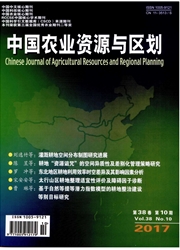

 中文摘要:
中文摘要:
农作物空间格局指特定区域内农作物种植结构、空间分布等信息,是农业土地系统的核心内容之一,也是农业结构调整的重要依据。随着空间模拟技术的发展,农业土地系统的时空动态表达成为可能,但传统模型方法更多关注土地利用类型的转化,而忽视耕地内部农作物格局时空特征的表达。该研究基于CLUE—S土地利用变化模拟模型,进行了概念模型设计、框架和模块重建、参数本底化和校正,研究并提出一个适用于我国农作物空间格局动态变化模拟模型(CROPS,CropPatternSimulator)的可行架构,使其能够实现区域尺度土地利用变化与农作物空间格局变化的双层动态模拟。CROPS模型采用了两层次嵌套模拟的模型结构,第一个层次实现对耕地空间格局动态变化过程和状态的表达,第二层次基于第一层次的模拟输出的耕地空间格局,实现耕地内部的农作物空间格局动态变化的有效模拟。CROPS模型主要包括非空间和空间两个大模块,空间模块又包括空间模块I和空间模块II。CROPS模型在东北三省进行了区域应用,结果表明,模型总体模拟效果较好,能够科学合理的表达耕地空间格局和农作物空间格局的动态变化过程。
 英文摘要:
英文摘要:
Crop spatial pattern refers to the temporal and spatial combination of diverse crop allocation, crop distri- bution, annual multi - cropping, land fallow, and other planting methods in a specific region, which is of extreme significance for crop yield and acreage estimations, and it is also the basis of structural adjustment and optimiza- tion. However, crop pattern dynamics are hardly represented by traditional spatial simulation technique (e. g. land change models) which mainly distinguish the land surface by different land use and land cover types, but crop pat- tern may change frequently and drastically without any change in land cover level. Based on the theory and applica- tions of the widely - used CLUES land change model, a multi level simulation model, CROPS ( Crop Pattern Simu- lator), was conceptualized to represent the detailed land system change, not only for land use conversions (e. g. the transitions among forest, cropland, and built-up), but also for crop pattern dynamics (e. g. the transitions a- mong maize, flee, and soybean). The representation of crop pattern dynamics was automatically nested after the representation of cropland allocation in each single modeling step. The conceptual CROPS model was further ap- plied to a case study in Northeast China (Liaoning, Jilin, and Heilongjiang Provinces). Results showed that it can finely capture the spatial - temporal characteristics of land use and crop pattern in the study region from 1980--2010.
 同期刊论文项目
同期刊论文项目
 同项目期刊论文
同项目期刊论文
 Proposing an interdisciplinary and cross-scale framework for global change and food security researc
Proposing an interdisciplinary and cross-scale framework for global change and food security researc Global-scale modelling of potential changes in terrestrial nitrogen cycle from a growing nitrogen de
Global-scale modelling of potential changes in terrestrial nitrogen cycle from a growing nitrogen de Simulated impact of elevated CO2, temperature and precipitation on winter wheat yield in North China
Simulated impact of elevated CO2, temperature and precipitation on winter wheat yield in North China Study on the feasibility and reasonability of the calculation methods of consolidating rural residen
Study on the feasibility and reasonability of the calculation methods of consolidating rural residen Retrieval of land surface temperature and emissivity from ASTER1B data using a dynamic learning neur
Retrieval of land surface temperature and emissivity from ASTER1B data using a dynamic learning neur Spatiotemporal Changes in the Rice Planting Area and Their Relationship to Climate Change in Northea
Spatiotemporal Changes in the Rice Planting Area and Their Relationship to Climate Change in Northea Spatio-Temporal Changes in the Rice Planting Area and Their Relationship to Climate Change in Northe
Spatio-Temporal Changes in the Rice Planting Area and Their Relationship to Climate Change in Northe 期刊信息
期刊信息
